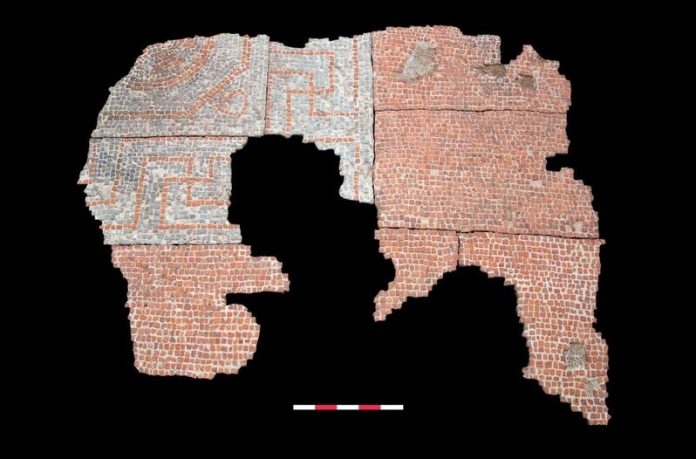[ccfic]
A new film produced by the University of Leicester showcases how archaeologists successfully lifted and conserved a Roman mosaic found in Leicester.
During the winter of 2016/17, archaeologists from University of Leicester Archaeological Services (ULAS) excavated a large site in Leicester, on the corner of Highcross Street and Vaughan Way next to the John Lewis car park. The project uncovered exciting new evidence for Leicester’s Roman past, including the remains of a Roman house which still contained pieces of mosaic floors in three rooms.

As part of the project, it was decided that the largest fragment of mosaic would be saved for future display. Now, a new film by University of Leicester video producer Carl Vivian reveals how a conservator, assisted by archaeologists, was able to successfully lift and conserve such a large but fragile object. The mosaic was in a very delicate condition. After more than 1,500 years buried in the ground the mortar grouting had decayed away and soil was the only thing holding it together. The archaeological conservator, Theo Sturge, helped by the team from ULAS, had the added challenge of having to lift the mosaic in the less-than-optimal cold and damp weather conditions of winter.
The mosaic, which measures some 2m by 3m, is one of the largest pieces to be found in Leicester in the last 30 years. It dates to the late 3rd or early 4th century AD, and it would originally have been in a square room in the house (the fragment is about a quarter of the original floor). It is made of small cubes of stone and brick, each about 20mm square, known as tesserae. There is a thick border of red tesserae surrounding a central square of grey tesserae. Picked out in red in the grey square are several decorations, including a geometric border of ‘Swastika meander’, foliage and a central flower-like pattern called a hexafoil.

Mathew Morris, Project Officer at ULAS, said: “The mosaic is not of the same high quality as the famous Blackfriars mosaic, which was found in Leicester in the 19th century and is one of the finest mosaics in Britain. Instead, it is likely to be typical of the type of floor more widely affordable to many of the Roman town’s population.
“Lifting it was a huge challenge which was only successfully achieved because of the efforts of the entire team working closely together. The mosaic is made-up of thousands of tiny tesserae. These all had to be lifted and kept in the correct sequence to preserve the pattern on the mosaic. This was done by gluing hessian to the mosaic’s surface to hold it together, then the mortar base into which the tesserae were set was cut away so that thin boards could be slid underneath the mosaic. The mosaic was then carefully lifted in sections and taken to the studio of our conservator, Theo Sturge, who had the challenge of conserving and re-assembling it.”

Archaeological Conservator Theo Sturge said: “Many years ago, when I worked for Leicester Museum, I lifted the Blackfriars Mosaic. Coming back to Leicester to lift another, rather more humble, mosaic was a nostalgic trip. Ideally, we would have lifted it in warm dry conditions but this was not an option. Instead it was cold and damp and getting adhesive to stick was challenging. With the help of the archaeologists it proved possible – just.”
Mathew Morris added: “The finished mosaic looks fantastic, Theo has done an amazing job putting it back together. In some ways it’s quite unusual to go to this level of effort and cost to conserve a mosaic of this quality, but actually because of its poorer quality you can see the craftsmanship behind it. You can see the direction the Roman workers were laying the stones in, you can see at one point one of the lines started to bend off and so they’ve had to turn one line into three to create a straight edge again. It’s these little human touches and errors that you can see in it that are important because they give you those glimpses into how it was made, who made it and their attitude to work, that gives you that real insight into the people of Roman Leicester.”
The excavation and conservation of the mosaic was funded by Sowden Group Ltd, which is developing the site into apartments. Conservation of the mosaic was carried out by Theo Sturge of the Sturge Conservation Studio, and the finished mosaic has now returned to Leicester in preparation for its future display.
To find out more about the mosaic, explore these 3D models of the mosaic before and after conservation:


